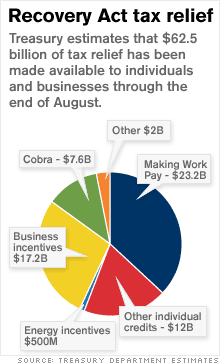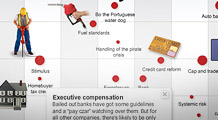Stimulus tax relief: Who's feeling it
Treasury has doled out $62.5 billion in tax breaks from the Recovery Act, but economists are split about how effective they have been.

NEW YORK (CNNMoney.com) -- Are you feeling the relief?
This week, Americans got their first glimpse at exactly where the Recovery Act's tax relief is heading.
The six-month-old plan includes $288 billion of tax relief, and Treasury has made $62.5 billion of that available so far -- in the form of credits, payments and incentives to individuals and businesses.
Previously, Treasury has only provided a monthly total but the detailed figures show that most of the spending is on track.
The vast majority of tax relief is going to individuals, with the biggest chunk steadily appearing in workers' paychecks.
But economists are divided about just how stimulating the tax relief has been.
Making Work Pay. The biggest chunk for individuals is coming in the form of a refundable credit of up to $400 per person and up to $800 per couples who file jointly. For most workers, the credit shows up in their paychecks in $15 slices, assuming 26 pay periods per year.
So far, Treasury has made $23.2 billion available for the credits, known as Making Work Pay. The Congressional Budget Office estimated in February that the program would cost the government $116 billion through 2010.
Under the Bush administration, most individuals received a one-time $600 tax rebate in 2008. That helped lead to a temporary blip in spending.
But research has shown that people spend a larger chunk of what they get if the funds flow consistently than in one large sum.
In an effort to spur that type of spending, and ultimately help boost the economy, the Obama plan spreads out the $400 credits over the course of the year for two years.
There is significant debate over whether the effort is working as planned.
Consumer spending still took a 1% dive in the second quarter, according to the Commerce Department. But Dean Baker, co-director of the Center for Economic and Policy Research, said spending levels would have been much lower had the Recovery Act not included the credits.
Other experts say the tax credits haven't done much -- at least to this point -- to stimulate the economy.
"Stimulus has added a cushion, but it's not enough to affect consumers' underlying conditions," said Doug Roberts, chief investment strategist for Channel Capital Research Institute. "Consumers are still over-leveraged and tend to put the credit into the bank."
Other individual credits. Economists who are skeptical of Making Work Pay's contributions say tax breaks targeting specific kinds of purchases have had a bigger impact.
For instance, the Recovery Act offered $8,000 in a refundable credit to first-time home buyers and tax deductions for new car purchases for those earning less than $125,000.
"Where the recovery package has seen real bang for its buck is in the use-it-or-lose-it incentives made available to consumers," said Bernard Baumohl, chief global economist at the Economic Outlook Group. "It's one of the few stimulating programs that has been very successful, because consumers want to take advantage of the deal before they lose it."
But Baker cautioned that those one-time incentive programs may hurt down the road.
"I'm troubled by these programs to the extent that they mostly just pull purchases forward that consumers would have made anyway down the road," said Baker. "Some bought items that they wouldn't have otherwise, but just moving up purchases doesn't help us get out of the downturn."
The government has so far made $12 billion of those individual credits available. Other individual credits also include $250 one-time payments for those who don't work, an Alternative Minimum Tax tax exemption, and college tuition credit among other programs. CBO estimated those credits would total $141 billion by the end of next year.
Business tax incentives. The Recovery Act has made $17.2 billion of tax breaks available for businesses to encourage companies to invest in equipment or to help them secure a cash cushion to get through the downturn and minimize layoffs.
Companies have used most of those incentives already. CBO had estimated in February that the incentives would total $23 billion this year.
Some economists are skeptical that the the tax breaks have done much to help businesses start spending again.
"Businesses don't want these subsidies now, they want to see more demand for their goods," said Baumohl. "How does simply giving tax incentives to invest going to help when there's already so much capacity that's not being used?"
On the other hand, Economic Outlook Group's Baker argued that that the incentives have stimulated manufacturing, especially in the energy sector, which has seen ethanol refinery construction soar in recent months.
Other tax relief. Stimulus includes several tax relief measures to help the vulnerable, the biggest of which is a provision to help eligible jobless workers pay for health insurance under Cobra.
Cobra coverage allows newly unemployed workers to keep health insurance provided by their former employers for a set period of time.
The government has been subsidizing 65% of the premiums under Cobra for up to 9 months for workers who have been laid off between Sept. 1, 2008, and Dec. 31, 2009. CBO estimated the cost of the Cobra tax relief would be $24.7 billion, and Treasury said it has so far made $7.6 billion available.
Treasury has also made $500 million of an estimated $22 billion in energy incentives available. The credit is for businesses to secure electricity produced by wind energy through 2012 and for electricity produced by other renewable resources through 2013. ![]()


